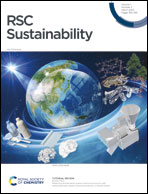Utilization of the nickel hydroxide derived from a spent electroless nickel plating bath for energy storage applications
Abstract
In this study, a simple one-step approach has been proposed to treat a spent electroless nickel plating bath by precipitating nickel metal as nickel hydroxide. Beta phase nickel hydroxide β-Ni(OH)2 generated after the treatment of an electroless nickel plating bath was characterized by material characterization techniques including X-ray diffraction (XRD), scanning electron microscopy (SEM), FT-IR and X-ray photoelectron spectroscopy (XPS). The electrochemical performance of β-Ni(OH)2 was evaluated using cyclic voltammetry (CV) and galvanostatic charge–discharge (GCD) techniques. A specific capacitance of 332 F g−1@5 mV s−1 is obtained from the CV data with an energy density of 11.5 W h kg−1 and power density of 207.5 W kg−1. The GCD results show a specific capacitance of 330 F g−1, which is in close agreement with the value obtained from the CV data. This work represents a scalable approach for the synthesis of β-Ni(OH)2 from plating waste and converting it into a value-added product. The β-Ni(OH)2 powder obtained from plating waste has comparable electrochemical properties to that of pristine β-Ni(OH)2 and other transition metal hydroxides produced by other chemical methods.



 Please wait while we load your content...
Please wait while we load your content...